The Influence of Electric Vehicle Charging on Low Voltage Grids with Characteristics Typical for Germany
Abstract
1. Introduction
- What are the impacts on the grids caused by an increasing market penetration of EV?
- Are there substantial regional differences in distribution grid topologies which are relevant for EV charging?
- How decisive is the individual charging behaviour of EV users and the resulting simultaneity of the charging processes in grid analysis?
2. Low Voltage Grids
2.1. Low Voltage Test Grids
2.2. Unbalanced Loading or Charging
3. Limits for Grid Operation
4. Simultaneity in the Power Demand
4.1. The Concept of Simultaneity Factors
4.2. The Calculation of Simultaneity Factors for Different Grid Limits
5. Energy Demand of the Households and EVs
5.1. EV Charging
- The number of EVs in each low voltage grid is calculated multiplying the number of household with the penetration of EVs. The EVs are split between the different feeders according to the number of households in each feeder.
- In the second step, values for the charging power PChar, charging duration per kWh TChar, and energy capacity ECap of the battery are assigned to each EV. In this paper, these values were set to PChar = 8.0 kW, TChar = 0.1769 h/kWh, and ECap = 15.7 kWh. The values were set to representative values for the German EV market.
- To calculate the daily simultaneity factor, an arrival time TArr was assigned to each EV randomly using the probability distribution shown in Table 3 [25]. As the accuracy of the distribution is one hour, we assumed a uniform distribution within each hour. Not all cars are used daily; this was taken into account with a probability for daily charging of 78% [26].
- In the fourth step, the s before Start and after End the charging process are determined. These depend on the chosen scenario and are, therefore, explained in detail in Section 6. The necessary charging energy ECharging is calculated as follows
- The duration of the charging process TDur is determined as follows:
- The end-time of the charging process TEnd is calculated using the arrival time TArr and the duration of the charging process TDur.
- In the seventh step, the maximum daily simultaneity factor is determined by generating a charging profile for each EV and by considering TArr and TEnd of each EV.
- Finally, the charging profile is divided between the different phases following the input data. For each phase, all profiles are added to a common charging profile NEV,Profile,PhaseX. Then, the maximum number of simultaneously charging cars NEV,Simul,PhaseX is reviewed for the grid and each feeder. This number is then divided by the total number of cars NEV,Total in each grid or feeder to calculate the simultaneity factor of the EV charging process. NEV,Total corresponds to the number of involved grid customers n as introduced in Section 4.1 and has to be determined depending on the grid limit that has to be verified, as explained in Section 4.2.The maximum peak power PEV,Peak can then be calculated as follows.
5.2. Energy Consumption of Households
5.3. Total Energy Consumption
6. Scenarios
7. Results
7.1. Impact of the Different Scenarios
7.2. The Campestral Grid
7.3. The Rural Grid
7.4. The Suburban Grid
7.5. Comparison of the Different Types of Low Voltage Grids
7.6. Voltage Unbalance in the Low Voltage Grids
8. Summary and Outlook
Author Contributions
Funding
Conflicts of Interest
Abbreviations
| EV | Electric vehicle |
| LV | Low voltage |
| MV | Medium voltage |
| BEV | Battery Electric Vehicle |
| PEV | Plug-In Electric Vehicle |
| PHEV | Plug-In-Hybrid Electric Vehicle |
| State of Charge |
References
- International Energy Agency (IEA). Global EV Outlook; International Energy Agency (IEA): Paris, France, 2018. [Google Scholar]
- Clement-Nyns, K.; Haesen, E.; Driesen, J. The impact of charging plug-in hybrid electric vehicles on a residential distribution grid. IEEE Trans. Power Syst. 2009, 25, 371–380. [Google Scholar] [CrossRef]
- Clement-Nyns, K.; Haesen, E.; Driesen, J. The impacts of vehicle-to-grid on the distribution grid. Electr. Power Syst. Res. 2011, 81, 185–192. [Google Scholar] [CrossRef]
- Habib, S.; Kamran, M.; Rashid, U. Impact analysis of vehicle-to-grid technology and charging strategies of electric vehicles on distribution networks—A review. J. Power Sources 2015, 277, 205–214. [Google Scholar] [CrossRef]
- Yong, Y.J.; Ramachandaramrthy, V.K.; Tah, K.M.; Mithulananthan, N. A review on the state-of-the-art technolgies of electric vehicle, its impacts and prospects. Renew. Sustain. Energy Rev. 2015, 49, 365–385. [Google Scholar] [CrossRef]
- Rolink, J. Modellierung und Systemintegration von Elektrofahrzeugen aus Sicht der Elektrischen Energieversorgung. Ph.D. Thesis, TU Dortmund, Dortmund, Germany, 2013. [Google Scholar]
- Shareef, H.; Md Islam, M.; Mohamed, A. A review stage-of-the-art charging technologies, placement methodologies, and impacts of electric vehicles. Renew. Sustain. Energy Rev. 2015, 64, 403–420. [Google Scholar] [CrossRef]
- Jochem, P.; Märtz, A.; Wang, Z. How might the German distribution grid cope with 100% market share of PEV? In Proceedings of the 31th International Electric Vehicle Symposium, EVS31, Kobe, Japan, 30 September–3 October 2018. [Google Scholar]
- Tie, C.H.; Gan, C.K.; Ibrahim, K.A. The impact of Electric Vehicle Charging on a Residential Low Voltage Distribution Network in Malaysia. In Proceedings of the IEEE Innovative Smart Grid Technologies, Kuala Lumpur, Malaysia, 20–23 May 2014. [Google Scholar]
- Nobis, P. Entwicklung und Anwendung eines Modells zur Analyse der Netzstabilität in Wohngebieten mit Elektrofahrzeugen, Hausspeichersystemen und PV-Anlagen. Ph.D. Thesis, TU München, Munich, Germany, 2016. [Google Scholar]
- Babrowski, S.; Heinrichs, H.; Jochem, P.; Fichtner, W. Load shift potential of electric vehicles in Europe. J. Power Sources 2014, 255, 283–293. [Google Scholar] [CrossRef]
- Held, L.; Märtz, A.; Wirth, J.; Krohn, D.; Zimmerlin, M.; Suriyah, M.R.; Leibfried, T.; Jochem, P.; Fichtner, W. A Comparison of the Influence of Electric Vehicle Charging on Different Types of Low-Voltage Grids. In Proceedings of the 32nd Electric Vehicle Symposium (EVS), Lyon, France, 19–22 May 2019. [Google Scholar]
- Kerber, G. Aufnahmefähigkeit von Niederspannungsnetzen für die Einspeisung aus Photovoltaikkleinanlagen. Ph.D. Thesis, TU München, Munich, Germany, 2011. [Google Scholar]
- Held, L.; Uhrig, M.; Suriyah, M.; Leibfried, T.; Junge, E.; Lossau, S.; Konermann, M. Impact of electric vehicle charging on low-voltage grids and the potential of battery storage as temporary equipment during grid reinforcement. In Proceedings of the E-Mobility Integration Symposium, Berlin, Germany, 23 October 2017. [Google Scholar]
- DIN e.V. Voltage Characteristics of Electricity Supplied by Public Networks; DIN EN 50160/A1:2016-02; DIN e.V.: Berlin, Germany, 2016. [Google Scholar]
- Märtz, A.; Held, L.; Wirth, J. Simultaneity Factor Tool. Available online: https://doi.org/10.5281/zenodo.3364366 (accessed on 13 August 2019).
- Märtz, A.; Held, L.; Wirth, J.; Jochem, P.; Fichtner, W.; Suriyah, M.; Leibfried, T. Development of a Tool for the Determination of Simultaneity Factors in PEV Charging Processes. In Proceedings of the E-Mobility Integration Symposium, Dublin, Ireland, 14 October 2019. [Google Scholar]
- Kraftfahrtbundesamt, Jahresbilanz des Fahrzeugbestandes am 1. January 2019. Available online: https://www.kba.de/DE/Statistik/Fahrzeuge/Bestand/b_jahresbilanz.html (accessed on 3 September 2019).
- Kraftfahrtbundesamt, Bestand am 1. Januar 2019 nach Marken, Herstellern. Available online: https://www.kba.de/DE/Statistik/Fahrzeuge/Bestand/MarkenHersteller/marken_hersteller_node.html (accessed on 3 September 2019).
- Statistisches Bundesamt, Current Population. Available online: https://www.destatis.de/EN/Themes/Society-Environment/Population/Current-Population/Tables/census-sex-and-citizenship-2018.html (accessed on 3 September 2019).
- Kraftfahrtbundesamt, Bestand am 1. Januar 2019 nach Haltern. Available online: https://www.kba.de/DE/Statistik/Fahrzeuge/Bestand/Halter/halter_node.html (accessed on 3 September 2019).
- Bundesinstitut für Bau-, Stadt-und Raumforschung, Laufende Raumbeobachtung-Raumabgrenzungen. Available online: https://www.bbsr.bund.de/BBSR/DE/Raumbeobachtung/Raumabgrenzungen/deutschland/kreise/Kreistypen2/kreistypen_node.html (accessed on 3 September 2019).
- Statistisches Bundesamt, Households, by Type of Household. Available online: https://www.destatis.de/EN/Themes/Society-Environment/Population/Households-Families/Tables/lrbev05.html (accessed on 3 September 2019).
- Diefenbach, N.; Cischinsky, H.; Rodenfels, M.; Clausnitzer, K. Datenbasis Gebäudebestand; Report; IWU: Darmstadt, Germany, 2010. [Google Scholar]
- Stöckl, G. Integration der Elektromobilität in das Energieversorgungsnetz. Ph.D. Thesis, TU München, Munich, Germany, 2014. [Google Scholar]
- Figenbaum, E.; Kolbenstvedt, M. Learning from Norwegian Battery Electric and Plug-in Hybrid Vehicle Users; Institute of Transport Economics, Norwegian Centre for Transport Reasearch: Oslo, Norway, 2016. [Google Scholar]
- Uhrig, M. Lastprofilgenerator zur Modellierung von Wirkleistungsprofilen Privater Haushalte. Available online: http://doi.org/10.5281/zenodo.803261 (accessed on 13 August 2019).
- Statistisches Bundesamt, Energy Consumption. Available online: https://www.destatis.de/EN/Themes/Society-Environment/Environment/Material-Energy-Flows/Tables/electricity-consumption-households.html (accessed on 12 August 2019).
- Zimmerman, R.D.; Murillo-Sánchez, C.E.; Thomas, R.J. MATPOWER: Steady-State Operations, Planning and Analysis Tools for Power Systems Research and Education. IEEE Trans. Power Syst. 2011, 26, 12–19. [Google Scholar] [CrossRef]
- Held, L.; Krämer, H.; Zimmerlin, M.; Suriyah, M.R.; Leibfried, T.; Ratajczak, L.; Lossau, S.; Konermann, M. Dimensioning of battery storage as temporary equipment during grid reinforcement caused by electric vehicles. In Proceedings of the 2018 53rd International Universities Power Engineering Conference (UPEC), Glasgow, UK, 4–7 September 2018. [Google Scholar]



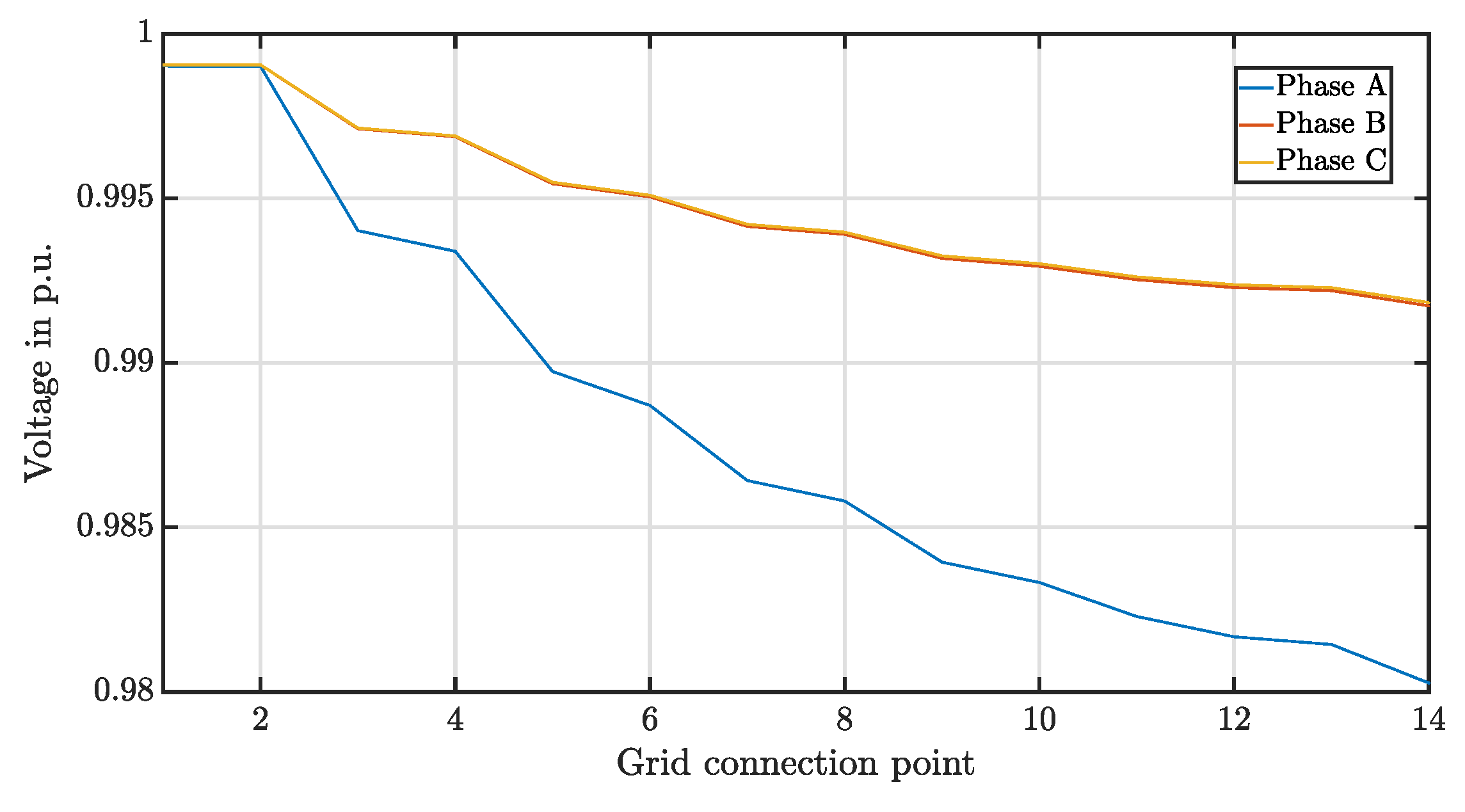
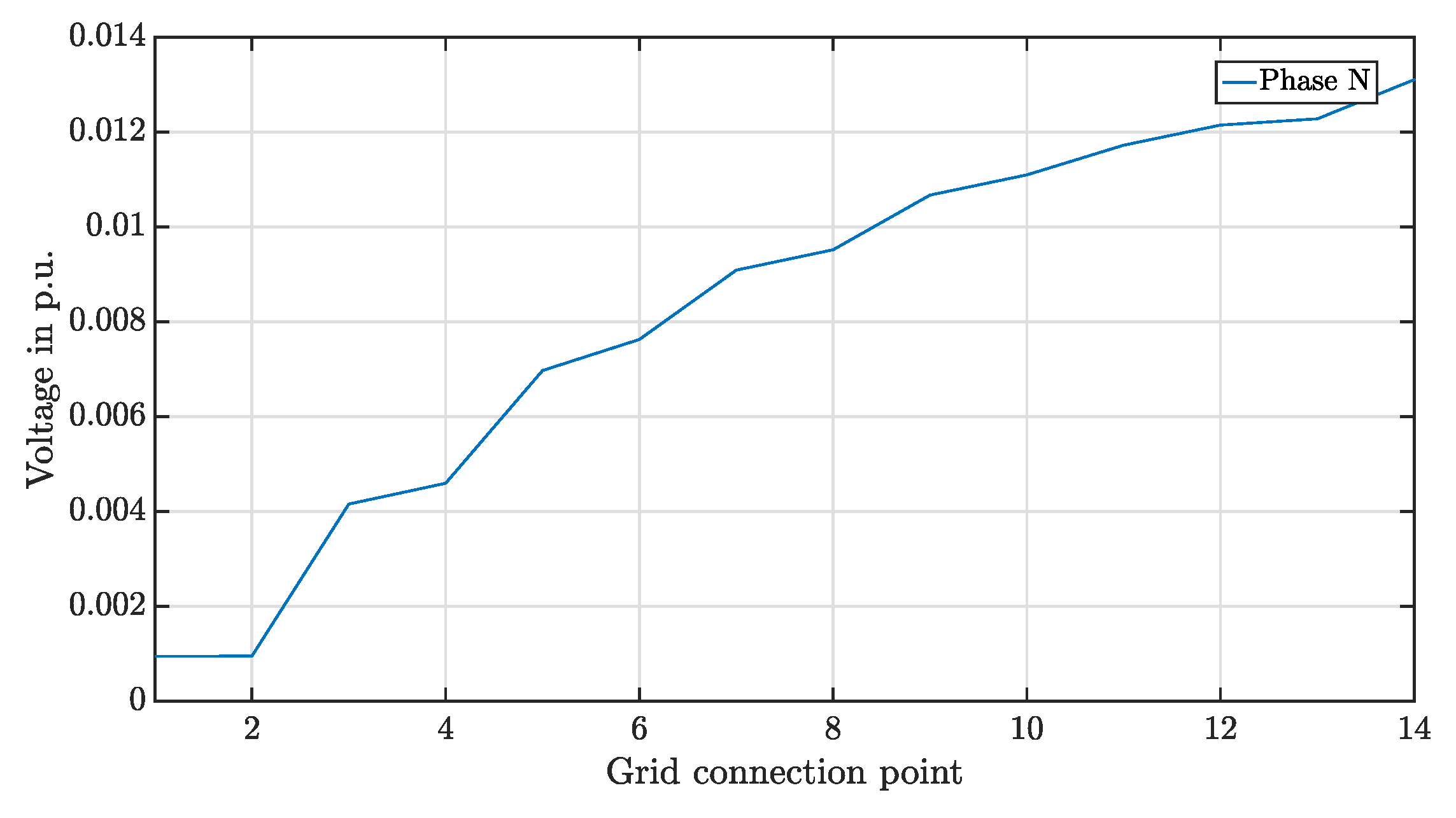

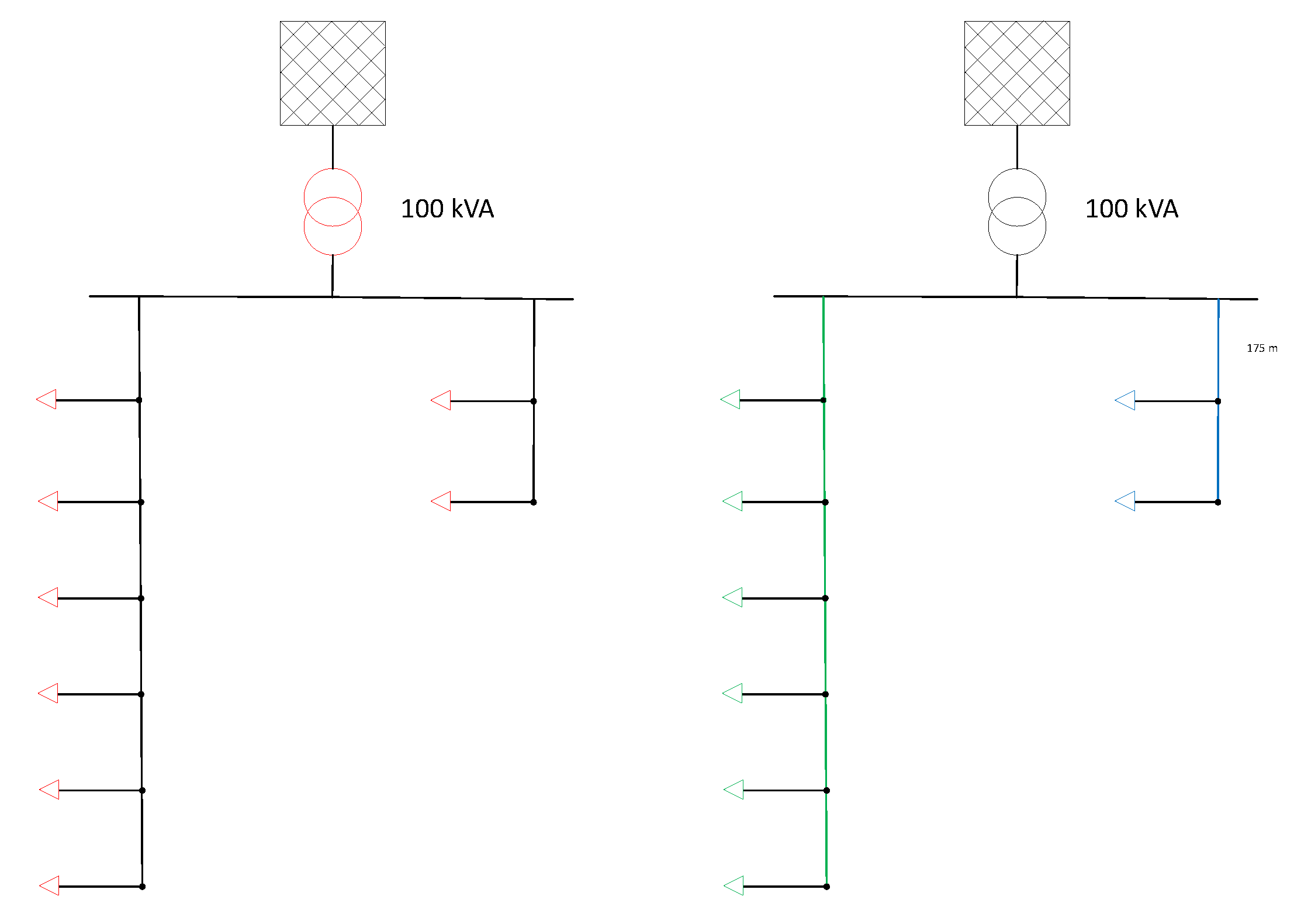
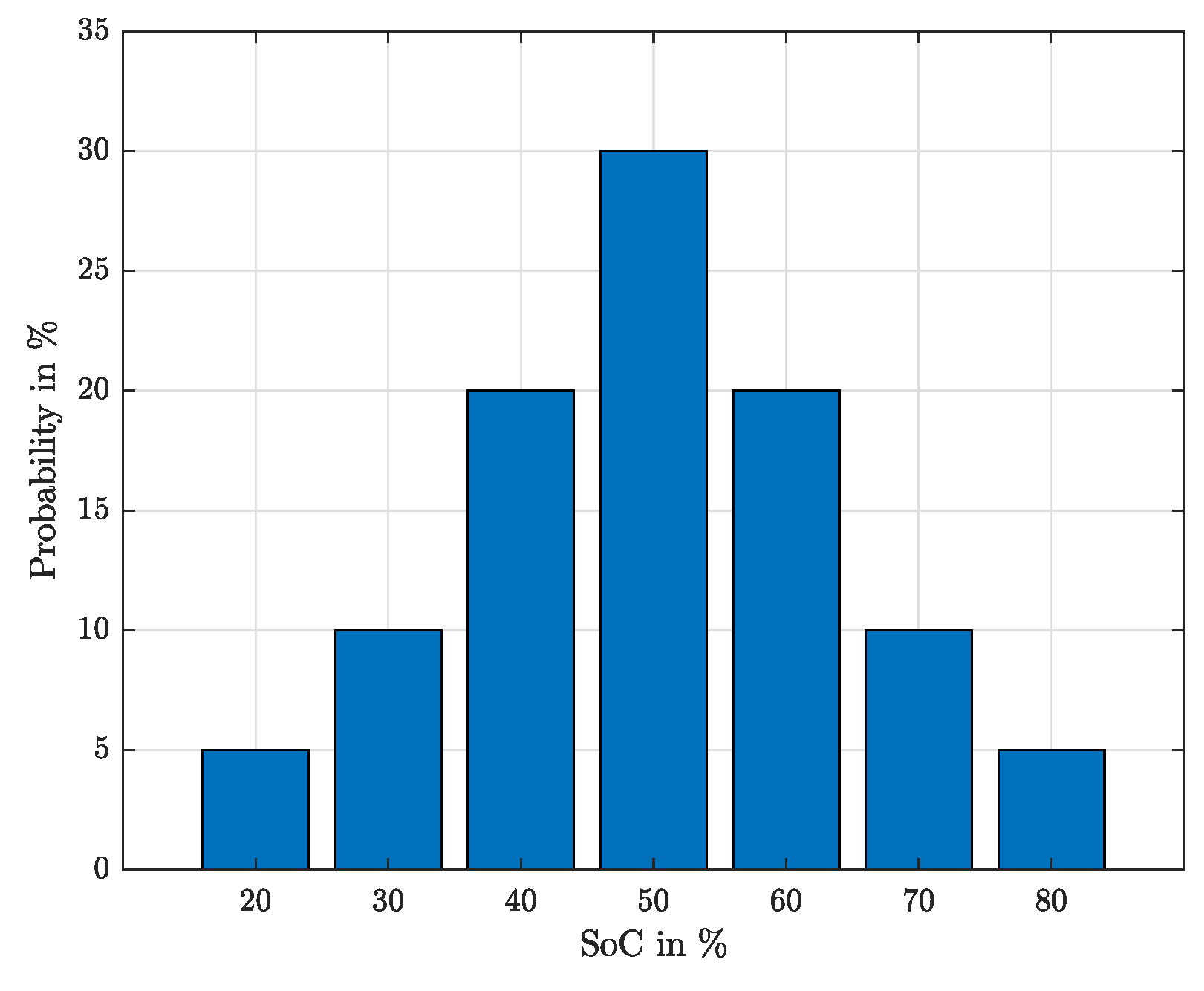
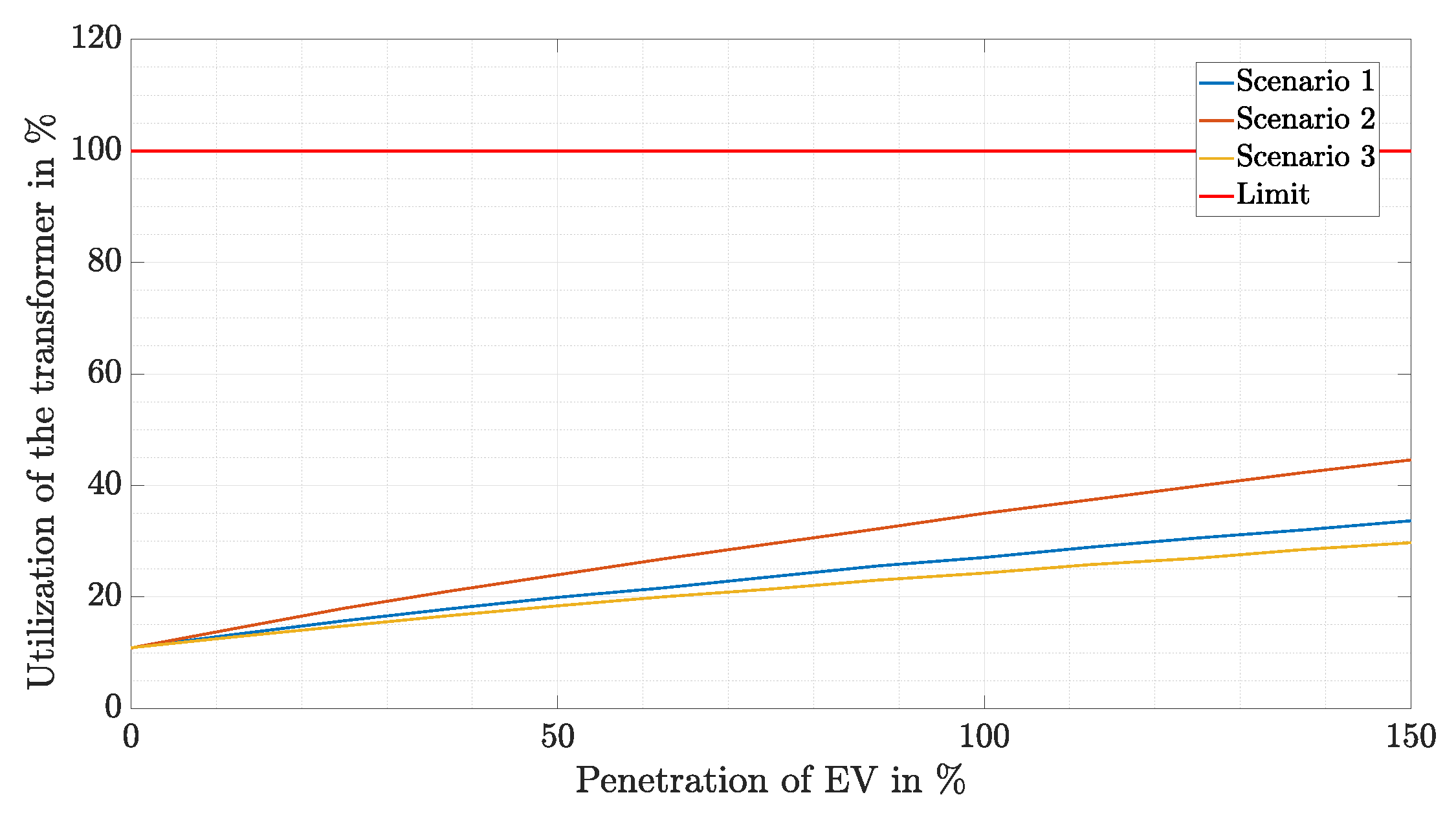

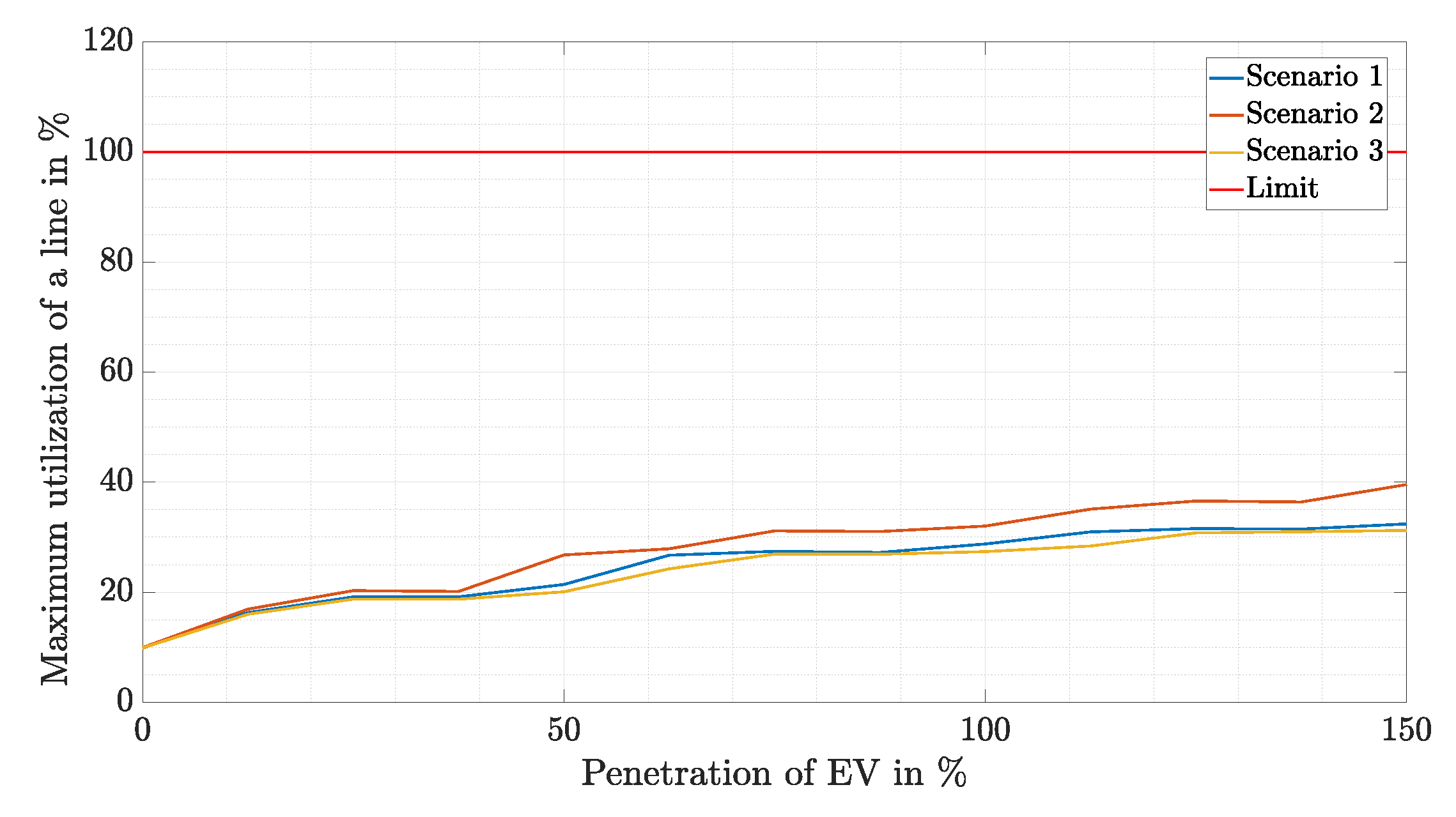
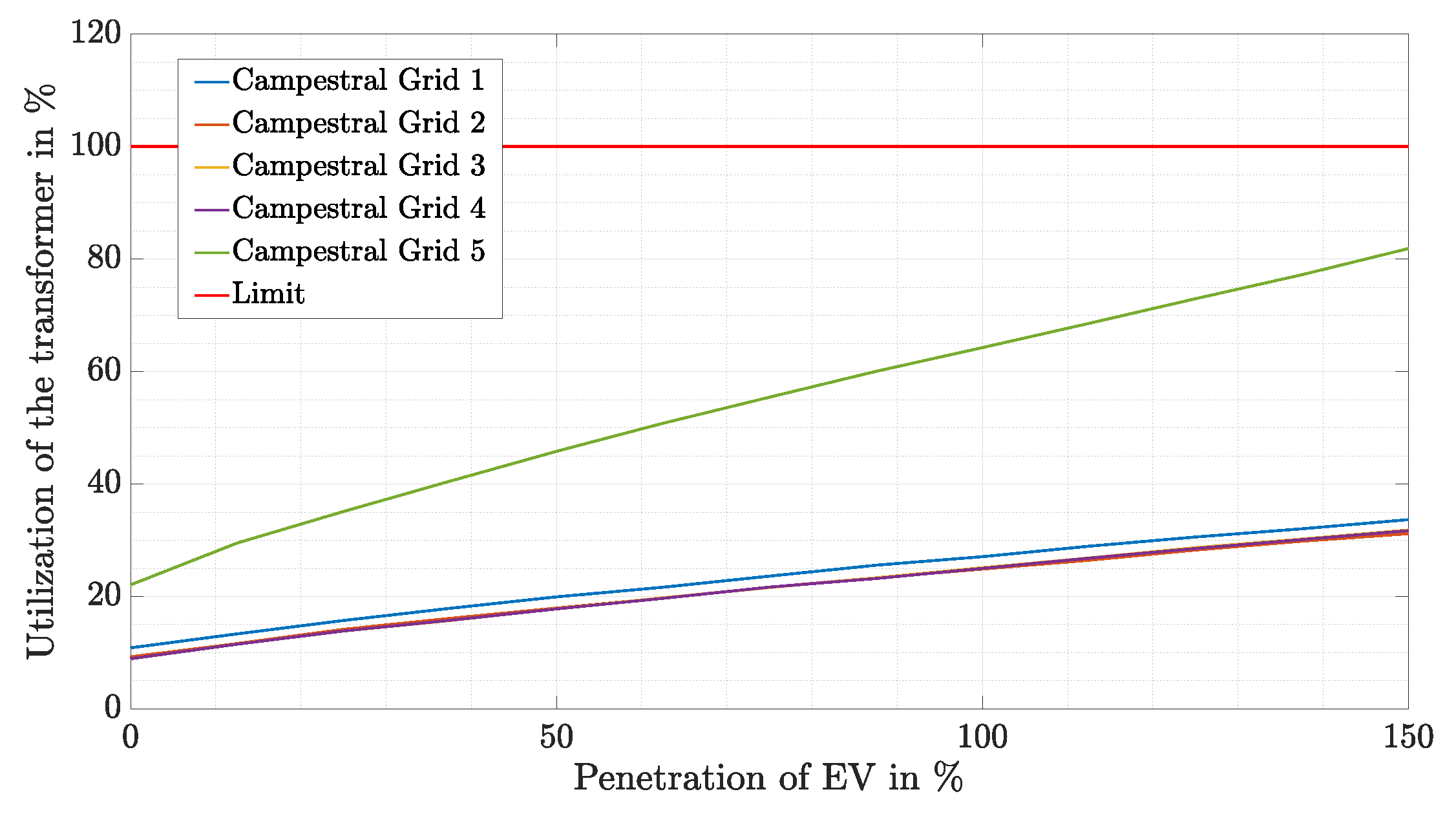

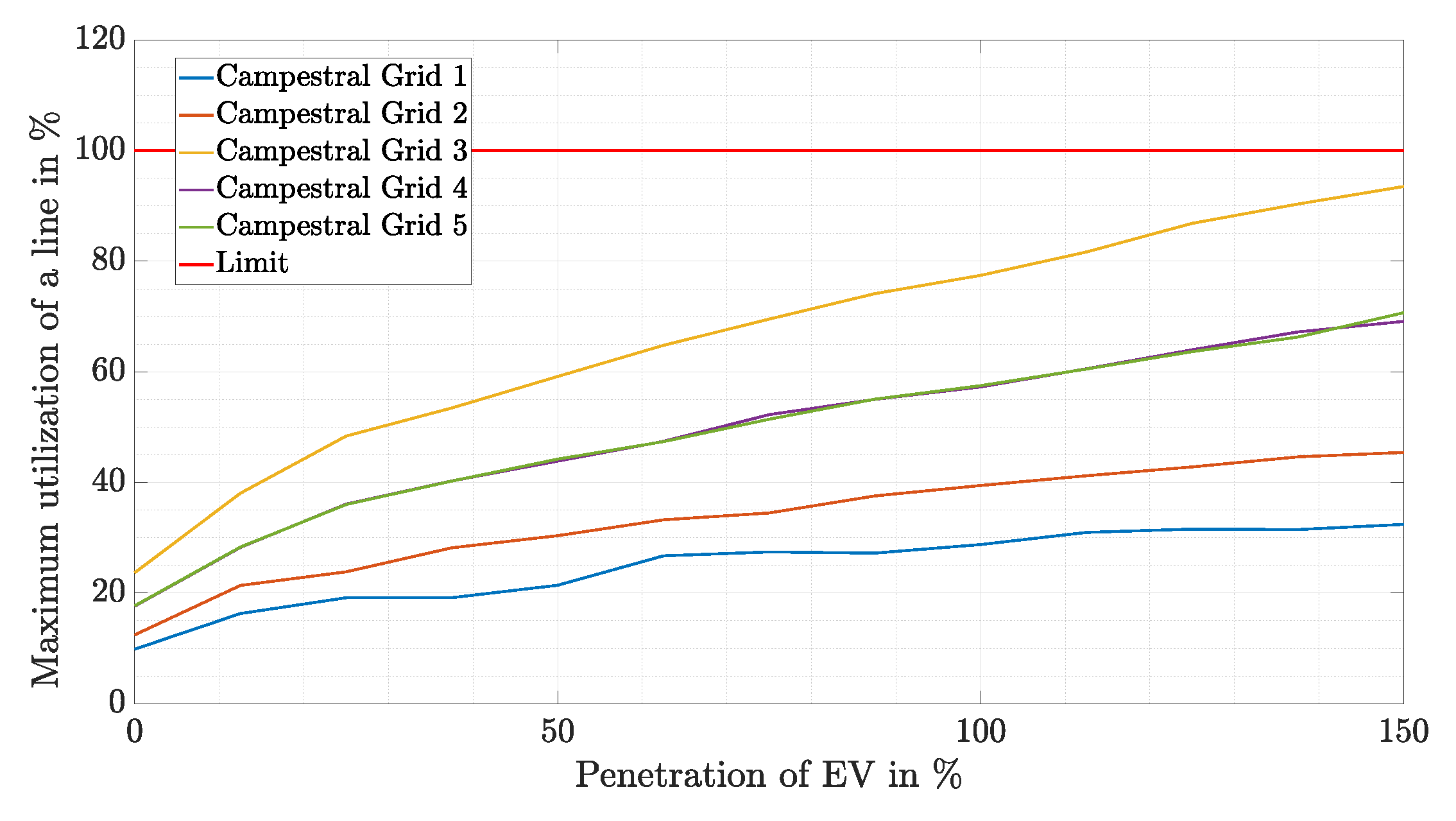
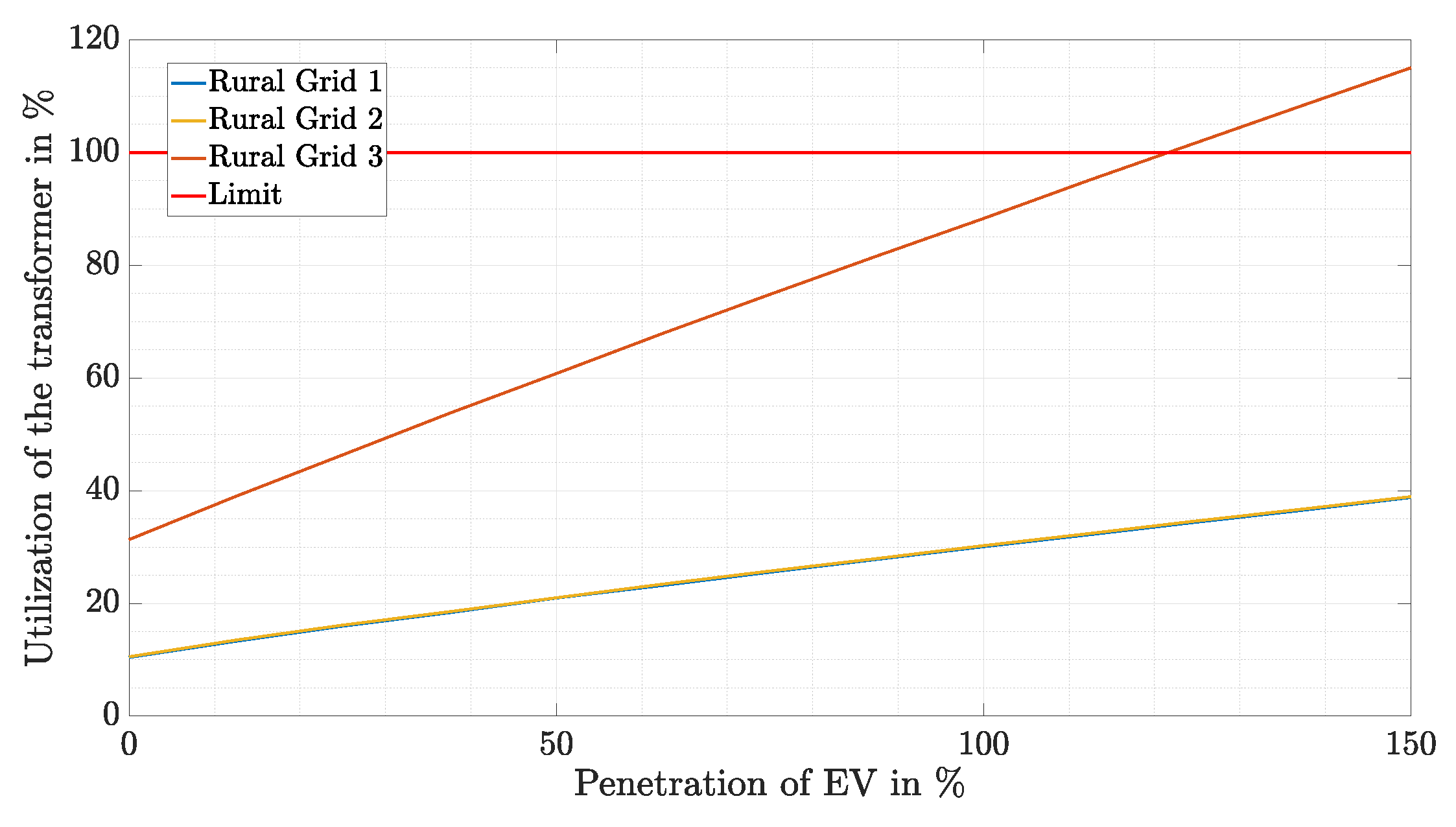
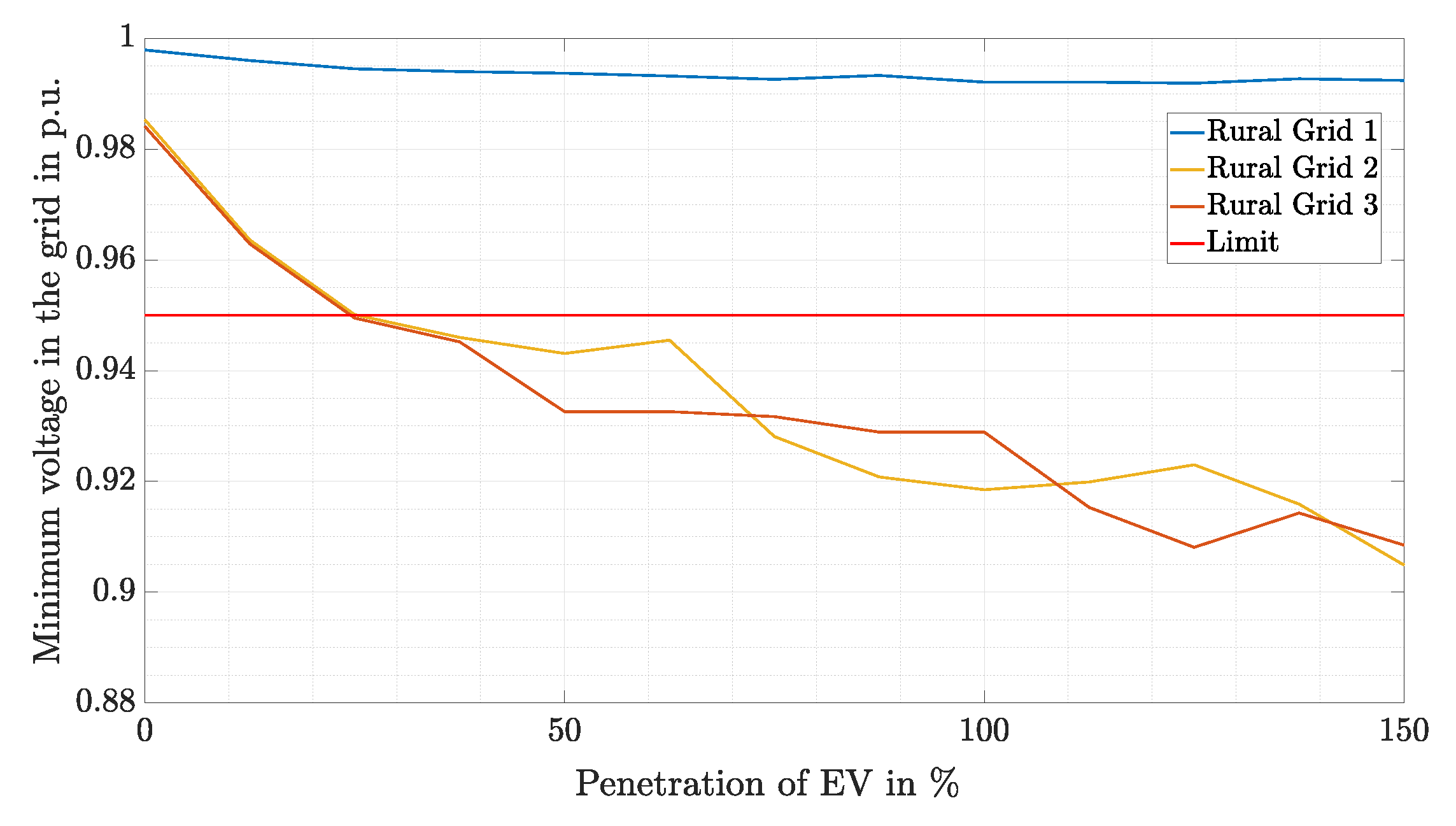
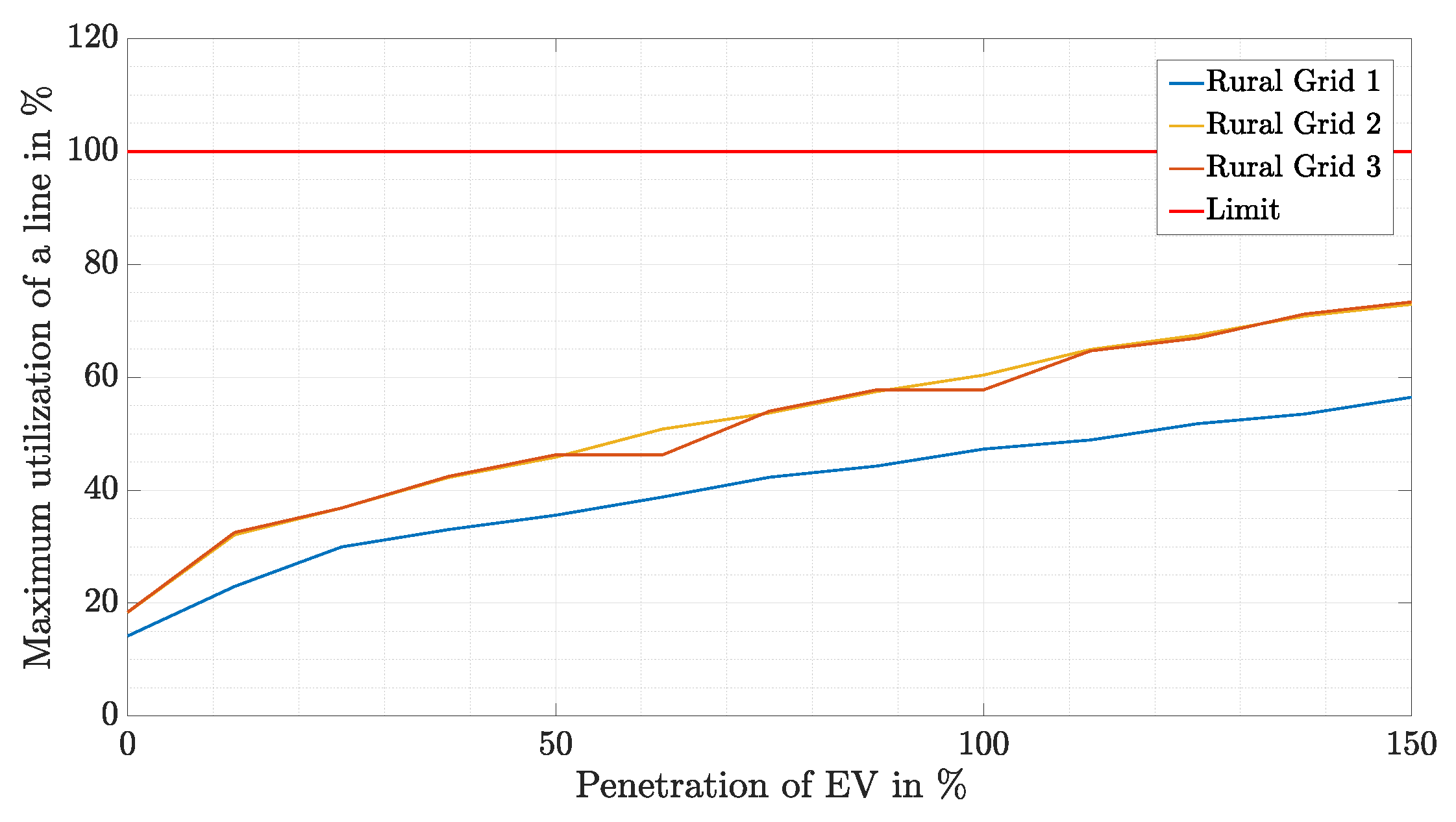
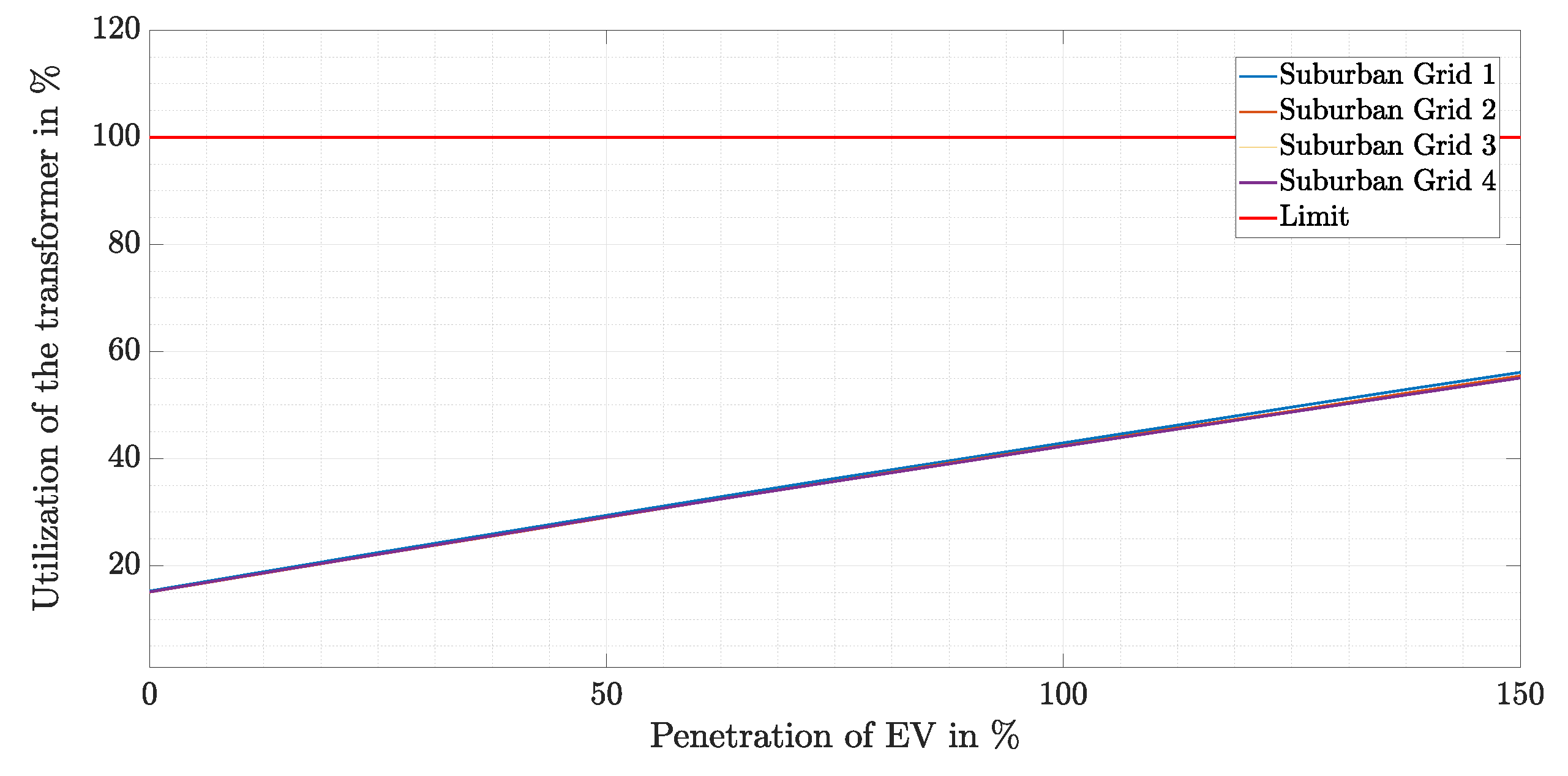
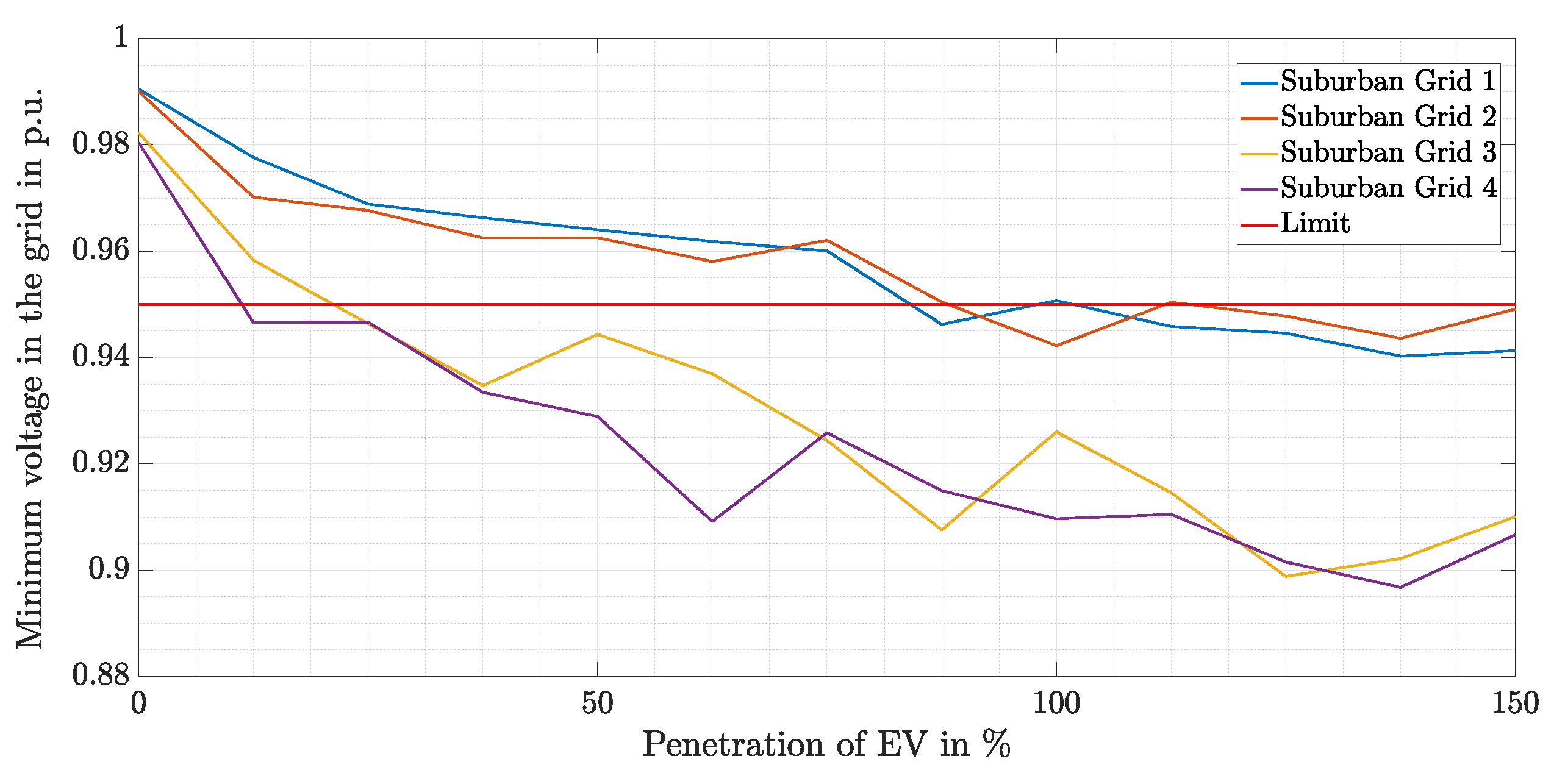
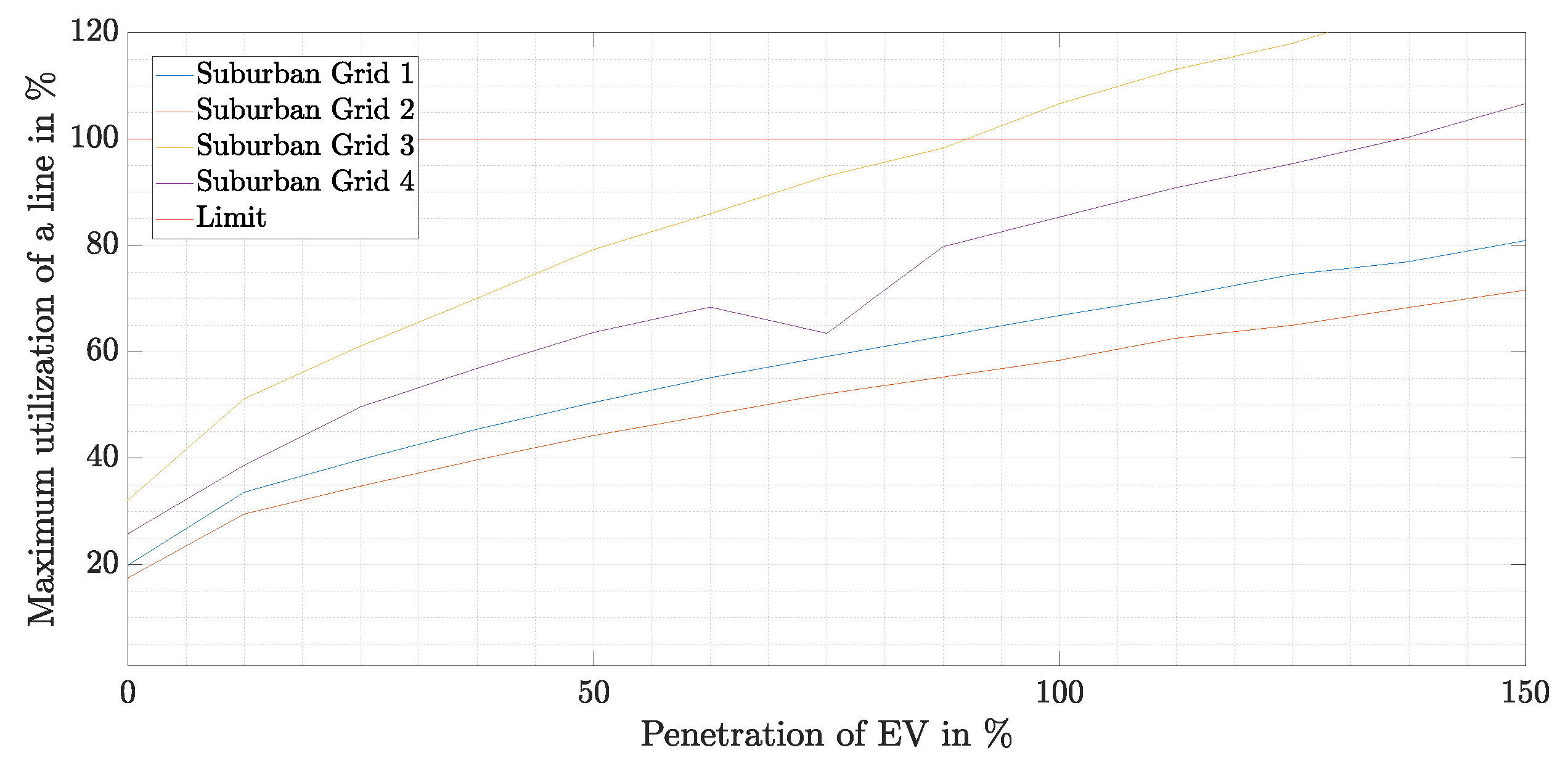
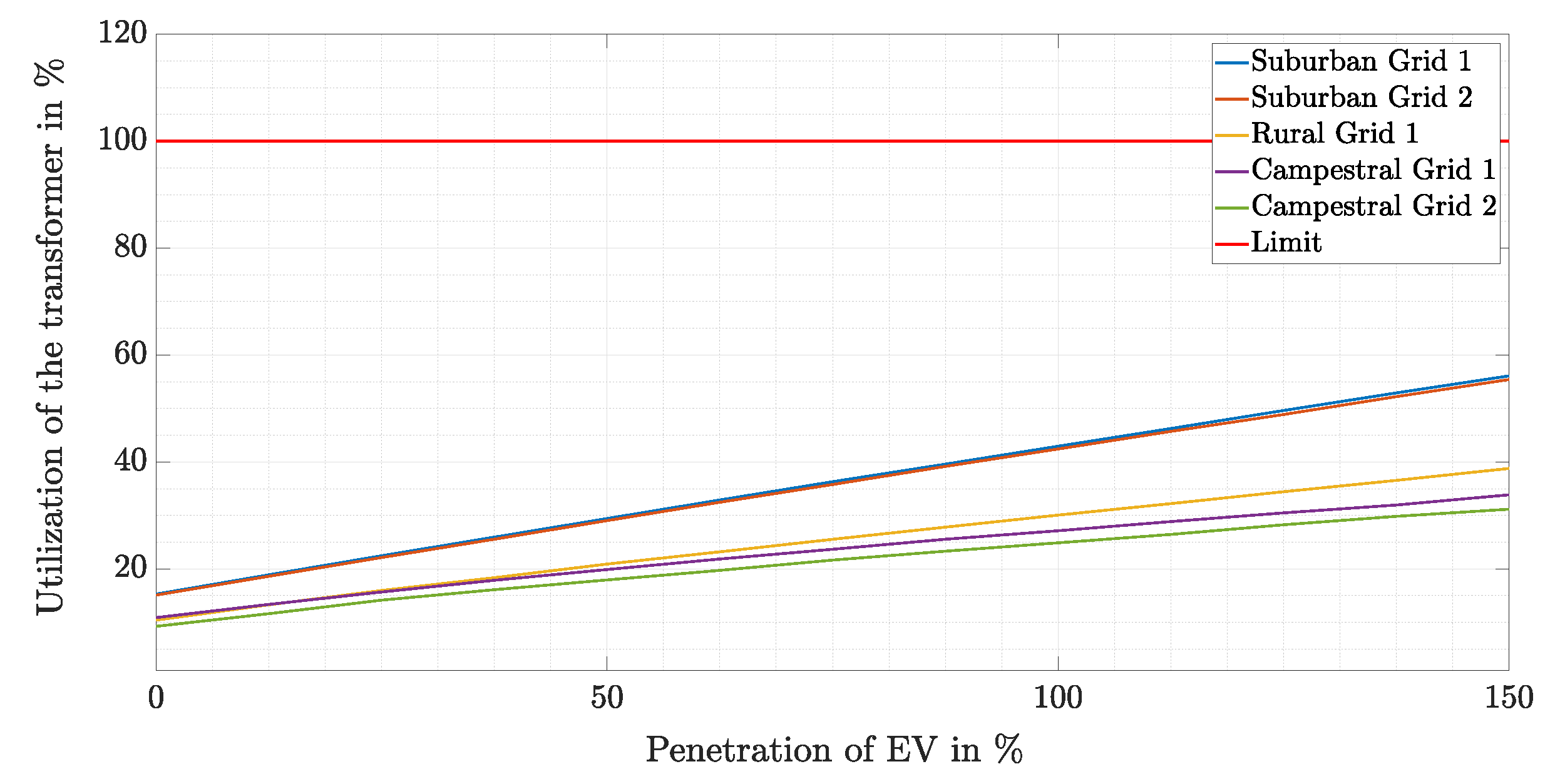
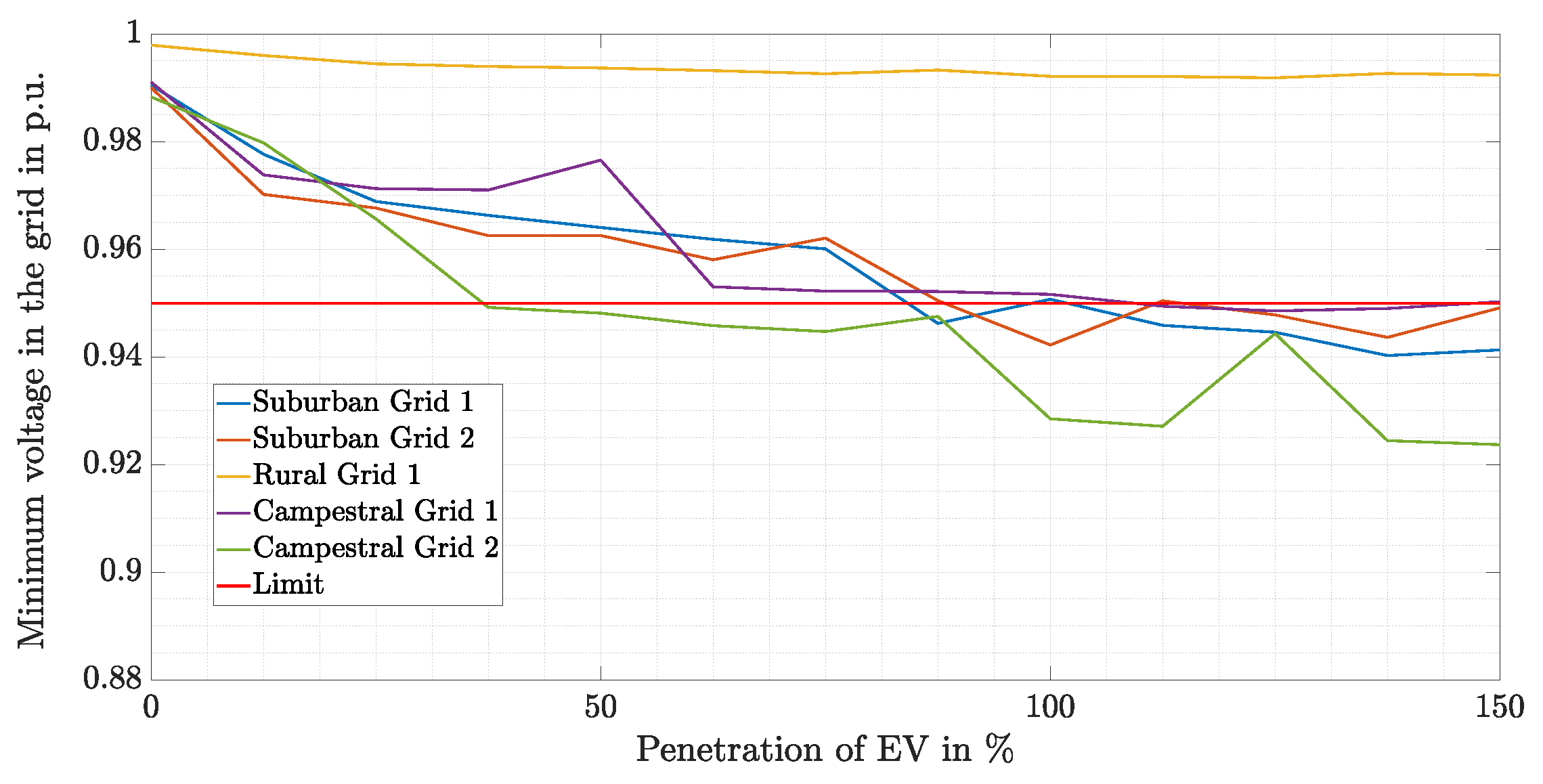
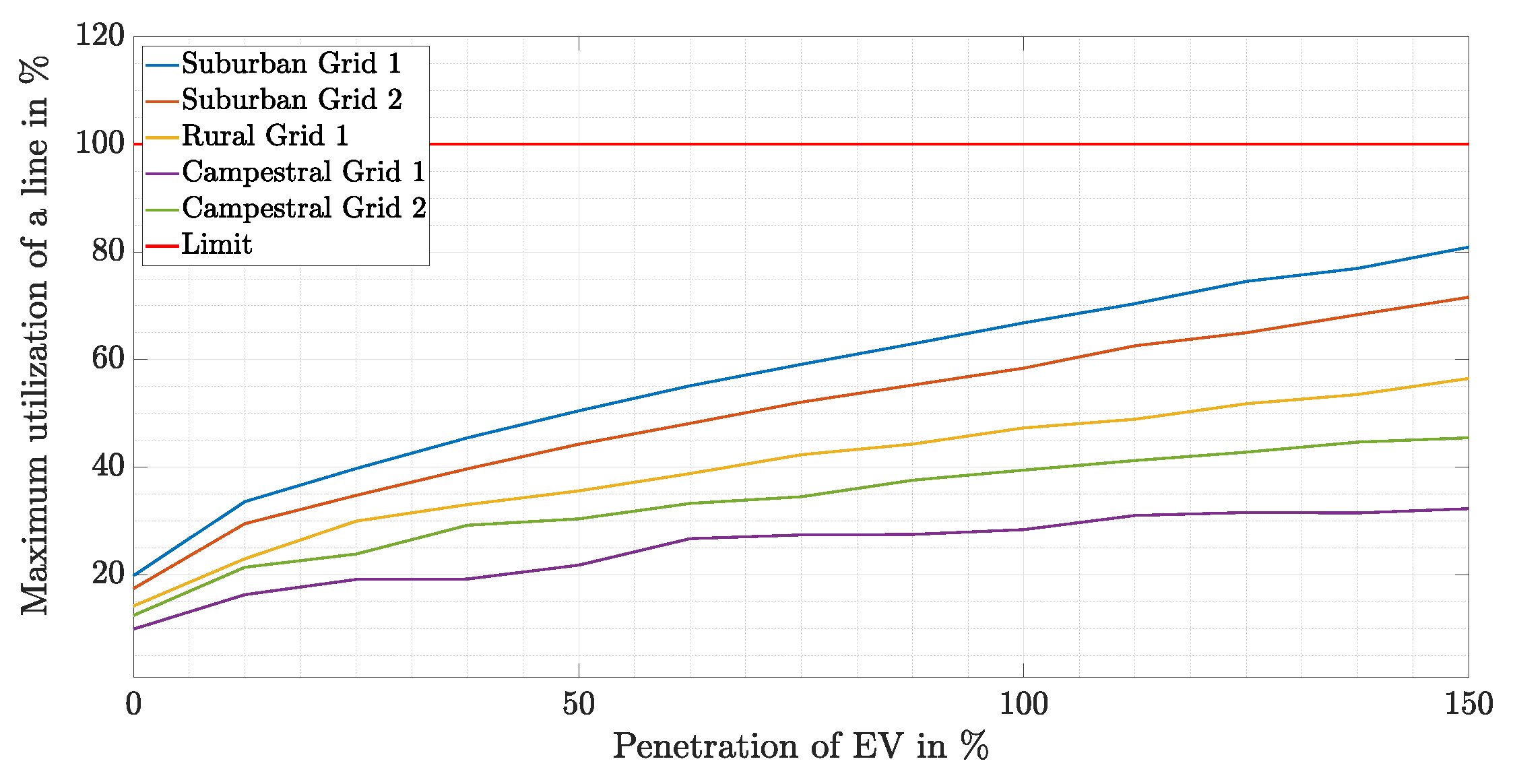
| Grid Name | Description |
|---|---|
| Campestral Grid 1 | Represents a typical grid for a campestral area. |
| Campestral Grid 2 | Represents an additional typical grid for a campestral area. In comparison to Campestral Grid 1, another transformer is used here and the grid structure is different. |
| Campestral Grid 3 | This grid is a campestral grid with an extremely long feeder. |
| Campestral Grid 4 | Campestral Grid 4 has a similar structure than Campestral Grid 3, but cable type and distance between the households is varied. |
| Campestral Grid 5 | Campestral Grid 5 is similar to Campestral Grid 4, but the nominal power of the transformer is lower as well as additional households are added. Campestral Grid 5 represents a campestral grid with extremely long feeder and highly utilized transformer. |
| Rural Grid 1 | Represents a typical grid for a rural area. |
| Rural Grid 2 | Represents a rural grid with an extremely long feeder. |
| Rural Grid 3 | In comparison to Rural Grid 2, here the nominal power of the transformer is lower as well as additional households exist, so that this grid represents a rural grid with extremely long feeder and a highly utilized transformer. |
| Suburban Grid 1 | Represents a typical grid for a suburban area. |
| Suburban Grid 2 | Represents a typical grid for a suburban area. In comparison to Suburban Grid 1, another cable type is used here. |
| Suburban Grid 3 | This grid represents a typical grid with an extremely long feeder in a suburban area. |
| Suburban Grid 4 | This grid represents a typical grid with an extremely long feeder in a suburban area. In comparison to Suburban Grid 3, another cable type is used here. |
| R (Ohm/km) | L (mH/km) | |
|---|---|---|
| NAYY 4 × 150 mm2 | 0.206 | 0.256 |
| NAYY 4 × 50 mm2 | 0.641 | 0.270 |
| Arrival Time | Probability | Arrival Time | Probability |
|---|---|---|---|
| 0:00–1:00 | 1.1% | 12:00–13:00 | 5.4% |
| 1:00–2:00 | 0.1% | 13:00–14:00 | 5.1% |
| 2:00–3:00 | 0.1% | 14:00–15:00 | 5.1% |
| 3:00–4:00 | 0.9% | 15:00–16:00 | 6.7% |
| 4:00–5:00 | 1.3% | 16:00–17:00 | 9.1% |
| 5:00–6:00 | 2.0% | 17:00–18:00 | 10.1% |
| 6:00–7:00 | 4.0% | 18:00–19:00 | 7.1% |
| 7:00–8:00 | 4.6% | 19:00–20:00 | 6.8% |
| 8:00–9:00 | 3.6% | 20:00–21:00 | 4.3% |
| 9:00–10:00 | 3.4% | 21:00–22:00 | 4.1% |
| 10:00–11:00 | 4.9% | 22:00–23:00 | 2.3% |
| 11:00–12:00 | 6.9% | 23:00–24:00 | 1.0% |
| Consideration of | ||||
|---|---|---|---|---|
| Simultaneity Factor | Start = 0% | End = 100% | Driving Distance | |
| Scenario 1 | x | x | ||
| Scenario 2 | x | x | x | |
| Scenario 3 | x | x | ||
| Grid Name | Voltage Unbalance in % |
|---|---|
| Campestral Grid 1 | 0.83 |
| Campestral Grid 2 | 1.18 |
| Campestral Grid 3 | 1.33 |
| Campestral Grid 4 | 1.48 |
| Campestral Grid 5 | 1.53 |
| Rural Grid 1 | 0.31 |
| Rural Grid 2 | 1.34 |
| Rural Grid 3 | 1.34 |
| Suburban Grid 1 | 0.82 |
| Suburban Grid 2 | 0.86 |
| Suburban Grid 3 | 1.37 |
| Suburban Grid 4 | 1.4 |
© 2019 by the authors. Licensee MDPI, Basel, Switzerland. This article is an open access article distributed under the terms and conditions of the Creative Commons Attribution (CC BY) license (http://creativecommons.org/licenses/by/4.0/).
Share and Cite
Held, L.; Märtz, A.; Krohn, D.; Wirth, J.; Zimmerlin, M.; Suriyah, M.R.; Leibfried, T.; Jochem, P.; Fichtner, W. The Influence of Electric Vehicle Charging on Low Voltage Grids with Characteristics Typical for Germany. World Electr. Veh. J. 2019, 10, 88. https://doi.org/10.3390/wevj10040088
Held L, Märtz A, Krohn D, Wirth J, Zimmerlin M, Suriyah MR, Leibfried T, Jochem P, Fichtner W. The Influence of Electric Vehicle Charging on Low Voltage Grids with Characteristics Typical for Germany. World Electric Vehicle Journal. 2019; 10(4):88. https://doi.org/10.3390/wevj10040088
Chicago/Turabian StyleHeld, Lukas, Alexandra Märtz, Dominik Krohn, Jonas Wirth, Martin Zimmerlin, Michael R. Suriyah, Thomas Leibfried, Patrick Jochem, and Wolf Fichtner. 2019. "The Influence of Electric Vehicle Charging on Low Voltage Grids with Characteristics Typical for Germany" World Electric Vehicle Journal 10, no. 4: 88. https://doi.org/10.3390/wevj10040088
APA StyleHeld, L., Märtz, A., Krohn, D., Wirth, J., Zimmerlin, M., Suriyah, M. R., Leibfried, T., Jochem, P., & Fichtner, W. (2019). The Influence of Electric Vehicle Charging on Low Voltage Grids with Characteristics Typical for Germany. World Electric Vehicle Journal, 10(4), 88. https://doi.org/10.3390/wevj10040088






